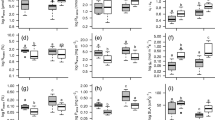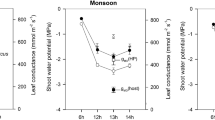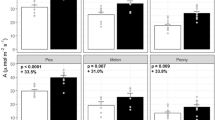Summary
Carbon isotope ratios, photosynthesis, and transpiration were measured on a xylem-tapping mistletoe (Phoradendron juniperinum) and its host (Juniperus osteosperma) in southern Utah, USA. For host tissues, the carbon isotope ratios agreed with theoretical values predicted from gas exchange observations. However, for mistletoe tissues, carbon isotope ratios deviated significantly from values predicted by gas exchange observations. This apparent discrepancy in mistletoe carbon isotope ratios can be resolved if one assumes that organic carbon dissolved in host xylem water was assimilated by the parasite. The mistletoes' high transpiration rates and low photosynthetic rates contributed to their heavy dependence on host xylem carbon. Two lines of evidence suggest that 62±2% of the carbon in the Utah mistletoe is derivated from the host and not from mistletoe autotrophic activities. Whereas xylem-tapping mistletoes have previously been characterized as wholly autotrophic parasites, we suggest that they may instead derive significant amounts of carbon from their hosts.
Similar content being viewed by others
References
Anderson PC, Brodbeck BV (1989) Diurnal and temporal changes in the chemical profile of xylem exudate from Vitis rotundifolia. Physiol Plant 75:63–70
Dawson TE, King EJ, Ehleringer JR (1990) Age structure of Phoradendron juniperinum, a xylem-tapping mistletoe: inferences from a non-destructive index of age. Am J Bot (in press)
Ehleringer JR, Schulze E-D (1985) Mineral concentrations in an autoparasitic Phoradendron californicum growing on a parasitic P. californicum and its host, Cercidium floridum. Am J Bot 72:568–571
Ehleringer JR, Schulze E-D, Ziegler H, Lange OL, Farquhar GD, Cowan IR (1985) Xylem-tapping mistletoes: Water or nutrient parasites? Science 227:1479–1481
Ehleringer JR, Cook CS, Tieszen LL (1986) Comparative water use and nitrogen relationships in a mistletoe and its host. Oecologia 68:279–284
Farquhar GD, O'Leary MH, Berry JA (1982) On the relationship between carbon isotope discrimination and the intercellular carbon dioxide concentration in leaves. Aust J Plant Physiol 9:121–137
Farquhar GD, Ehleringer JR, Hubick KT (1989) Carbon isotope discrimination and photosynthesis. Annu Rev Plant Physiol Plant Mol Biol 40:503–537
Glatzel G (1983) Mineral nutrition and water relations of hemiparasitic mistletoes: a question of partitioning. Experiments with Loranthus europaeus on Quercus petraea and Quercus robur. Oecologia 56:193–201
Goldstein G, Rada F, Sternberg L, Burguera JL, Burguera M, Orozco A, Montilla M, Zabala O, Azocar A, Canales MG, Celis A (1989) Gas exchange and water balance of a mistletoe species and its mangrove hosts. Oecologia 78:176–183
Govier RN, Nelson MD, Pate JS (1967) Hemiparasitic nutrition in angiosperms. I. The transfer of organic compounds from host to Odontites verna (Bell.) Dum. (Scrophulariaceae). New Phytol 66:285–297
Graves JD, Press MC, Stewart GR (1989) A carbon balance model of the sorghum-Striga hermonthica host-parasite association. Plant Cell Environ 12:101–107
Hawksworth FG (1983) Mistletoes as forest parasites. In: Calder M, Bernhardt P (eds), The Biology of Mistletoes. Academic Press, New York
Hollinger DY (1983) Photosynthesis and water relations of the mistletoe, Phoradendron villosum, and its host, the California valley oak, Quercus lobata. Oecologia 60:396–400
Hull RJ, Leonard OA (1964) Physiological aspects of parasitism in mistletoes (Arceuthobium and Phoradendron). I. The carbohydrate nutrition of mistletoe. Plant Physiol 39:996–1007
Okonkwo SNC (1966) Studies of Striga senegalensis. II. Translocation of C14-labelled photosynthate, urea-C14 and sulphur-35 between host and parasite. Am J Bot 53:142–148
Press MC, Shah N, Tuohy JM, Stewart GR (1987) Carbon isotope ratios demonstrate carbon flux from C4 host to C3 parasite. Plant Physiol 85:1143–1145
Press MC (1989) Autorophy and heterotrophy in root parasites. Trends Ecol Evol 4:258–263
Raven JA (1983) Phytophages of xylem and phloem: a comparison of animal and plant sap-feeders. Adv Ecol Res 13:136–239
Rogers WE, Nelson RR (1962) Penetration and nutrition of Striga asiatica. Phytopathology 52:1064–1070
Schulze E-D, Ehleringer JR (1984) The effect of nitrogen supply on growth and water-use efficiency of xylem-tapping mistletoes. Planta 162:268–275
Schulze E-D, Turner NC, Glatzel G (1984) Carbon, water and nutrient relations of two mistletoes and their hosts: a hypothesis. Plant Cell Environ 7:293–299
Zimmermann MH, Brown CL (1979) Trees: Structure and Function. Springer, Berlin Heidelberg New York
Author information
Authors and Affiliations
Rights and permissions
About this article
Cite this article
Marshall, J.D., Ehleringer, J.R. Are xylem-tapping mistletoes partially heterotrophic?. Oecologia 84, 244–248 (1990). https://doi.org/10.1007/BF00318279
Received:
Accepted:
Issue Date:
DOI: https://doi.org/10.1007/BF00318279




